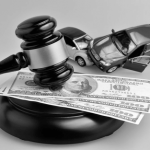Imagine it’s a typical Friday night. You just got done with work, and all you want to do is get home and relax. You start driving home when a young driver runs a red light and hits your car. You find out that the driver is only 16 years old, doesn’t own the vehicle, and he just got his license. Now, you are experiencing neck and back pain. You want to sue, but are unsure how the driver’s age and status as a non-owner affect your claim. Can you sue the owner of the vehicle in North Dakota?
Well, lucky for you, North Dakota has adopted the family car doctrine. The family car doctrine, also known as the family purpose doctrine, has been around for quite some time and has been adopted by many states, including North Dakota. It extends liability to the owner of the vehicle for negligent operation by one who is using the vehicle with the express or implied consent of the owner for the business or pleasure of the owner’s family. Okay, I know that was a mouth full! Generally speaking, it means that if the owner of the vehicle (in this situation, the parent) gives his or her child permission to drive the family car for the family’s business or pleasure, and the child gets into an accident, then the parent (owner of the vehicle) can be held responsible if the injured party sues.
Why Do We Have This Doctrine?
The family car doctrine was first adopted in North Dakota in 1919. The decision was based on the theory that the driver of a family car, in pursuit of recreation or pleasure, was engaged in the owner’s business. The family car doctrine promoted the public policy of giving an injured party a cause of action against a financially responsible defendant.
But, What If The Family Doesn’t Own The Car?
Under the doctrine, the head of the household must provide, but need not own, the vehicle for the use, pleasure, and business of himself/herself or a member of his/her family. The North Dakota Supreme Court considers the “totality of the circumstances” to determine if the family car doctrine applies.
In Herman v. Magnuson, the North Dakota Supreme Court established factors for determining whether the doctrine applies, including:
- who paid for the car,
- who had the right to control the use of the car,
- the intent of the parties who bought and sold the car,
- the intent of the parents and the child as to whom, between them, was the owner of the car,
- to whom the seller made the delivery of the car,
- who exercised property rights in the car from the date of its purchase to the date of the accident,
- and any other evidence that bears on the issue of who is the owner in fact.
Conclusion
While this doctrine may seem simple and straightforward, the individual facts of each case can add a great deal of complexity in its application. Each personal injury case is different, and this article only summarizes very technical laws, on which, you’d be best served to seek legal advice. If you or someone you know has been injured in an accident, feel free to contact our Personal Injury Team via email below or telephone at 701-297-2890. All initial consultations are free of charge, and all personal injury cases are handled on a contingency fee basis, meaning there is no fee unless there is a recovery in your case.










